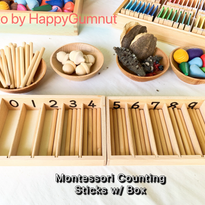
Observation of Focus Children
Stemmed from children engaging in a counting sticks mathematics activity during focus time
Child 1 – (5.5Y, B) Second Kindy Year, Prep 2026
Child 2 – (4.5Y, G) Prep 2026
Child 3 – (5.5Y, G) Second Kindy year, Prep 2026
Child 4 – (4Y, G) Prep 2026
Child 5 – (4Y, B) Prep 2026
Child 6 - (3.5Y, B) Another year of Kindy, Prep 2027
Child 7 – (4.5Y, G) Prep 2026
Child 8 – (4.5Y, B) Prep 2026
Counting Sticks - Individual Observations

Child 1 - 5.5Y B
Observation: I observed Child 1 enthusiastically waiting his turn to engage in a counting sticks game, Child 1 was excited by the concept and to have a go. I didn’t even have time to explain the game and Child 1 was able to put all of the correct amount sticks in the boxes for the correct numbers from 0-4 with no assistance. Straight after Henry achieved the 5-9 number boxes placing the correct amount of counting sticks with the number.
Analysis of learning: Child 1 is extending his numeracy skills through exposure to numbers and through a variety of number games and concepts. Child 1 confidently engages with symbols and patterns. Child 1 is extending on his number recognition of numbers from 1-10 and counting skills for numbers 1-10.
Extension of learning: To continue providing opportunities for Child 1 to engage with number experiences and gain confidence of recognition of numbers and counting abilities, by facilitating a challenge involving numbers 11-20. I will facilitate a number 1-10 bingo game, and 11-20 that promotes the use of number recall and retention. Also as option a numeracy game with numbered cars and matching them to their correct number parking space. Another fun game, to explore learning of numeracy and mathematical concepts with Child 1. Engaging with numeracy experiences in personally and meaningful ways.
EYLF: 4.1, 4.3, 5.3
QKLG: 4.1, 4.2, 5.3

Child 3 - 5.5Y G
Observation: I observed Child 3 enthusiastically waiting her turn to engage in a counting sticks game, Child 3 was excited by the concept and to have a go. I explained the game and role modelled how many sticks for each numbered box. Child 3 was able to put all of the correct amount stick in the boxes for the correct numbers from 0-4 with no assistance. Straight after she attempted the 5-9 number boxes but found the numbers challenging to recognise.
Analysis of learning: Child 3 is exploring her numeracy skills through exposure to numbers and through a variety of number games and concepts. Child 3 confidently engages with symbols and patterns. Child 3 is emerging on her number recognition of numbers 5-10 and exploring counting skills for numbers 1-10.
Extension of learning: To continue providing opportunities for Child 3 to engage with number experiences and gain confidence of number recognition and counting abilities, by facilitating a number 1-10 bingo game, that promotes the use of number recall and retention. Also to engage Child 3 in a numeracy game with numbered cars and matching them to their correct number parking space. Another fun game, to explore learning of numeracy and mathematical concepts with Child 3. Engaging with numeracy experiences in personally and meaningful ways.
EYLF: 4.1, 4.3, 5.3
QKLG: 4.1, 4.2, 5.3

Child 8 - 4.5Y B
Observation: I observed Child 8 engaging in a counting sticks game, Child 8 was excited by the concept. Once I explained the game, with some role modelling, Child 8 was able to put some of the correct number of sticks in the boxes for the correct number with assistance. Child 8 is displaying emerging number recognition of numbers 1-5.
Analysis of learning: Child 8 is emerging his numeracy skills through exposure to numbers and through a variety of number games and concepts. Child 8 engages with symbols and patterns. Child 8 is emerging his number recognition of numbers from 1-10 and emerging his counting skills for numbers 1-10
Extension of learning: To continue providing opportunities for Child 8 to engage with number experiences and gain confidence of number recognition and counting abilities. I will facilitate a number 1-10 bingo game, that promotes the use of number recall and retention. If Child 8 doesn’t show much interest in that game, I will use cars with numbers and matching them to their correct number parking space. Another fun game, to explore learning of numeracy and mathematical concepts with Child 8. Engaging with numeracy experiences in personally and meaningful ways.
EYLF: 4.1, 4.3, 5.3
QKLG: 4.1, 4.2, 5.3

Child 5 - 4Y B
Observation: I observed Child 5 engaging in a counting sticks game, Child 5 was excited by the concept. Once I explained the game, with some role modelling, Child 5 was able to put the correct number of sticks in the boxes for the correct number with assistance. Child 5 is displaying emerging number recognition of numbers 1-5.
Analysis of learning: Child 5 is emerging his numeracy skills through exposure to numbers and through a variety of number games and concepts. Child 5 engages with symbols and patterns. Child 5 is emerging his number recognition from 1-10 and exploring his counting skills for numbers 1-10.
Extension of learning: To continue providing opportunities for Child 5 to engage with number experiences and gain confidence of recognition of numbers and counting abilities. I will facilitate a number 1-10 bingo game, that promotes the use of number recall and retention. If Cild 5 doesn’t show much interest in that game, I will use cars with numbers and matching them to their correct number parking space. Another fun game, to explore learning of numeracy and mathematical concepts with Child 5. Engaging with numeracy experiences in personally and meaningful ways.
EYLF: 4.1, 4.3, 5.3
QKLG: 4.1, 4.2, 5.3

Child 4 - 4Y G
Observation: I observed Child 4 engaging in a counting sticks game, Child 4 was fascinated by the concept. Once I explained the game, with some role modelling, Child 4 was able to put the correct number of sticks in the boxes for the correct number. Child 4 is exploring her number recognition of numbers 5-10.
Analysis of learning: Child 4 is emerging her numeracy skills through exposure to numbers and through a variety of number games and concepts. Child 4 enthusiastically engages with symbols and patterns. Child 4 is exploring her number recognition and extending her counting skills for numbers 1-10.
Extension of learning: To continue providing opportunities for Child 4 to engage with number experiences and gain recognition of number and counting abilities. I will facilitate a number 1-10 bingo game, that promotes the use of number recall and retention. If Child 4 doesn’t show interest in that game, I will use cars with numbers and matching them to their correct number parking space. Another fun game, to extend on Child 4 learning of numeracy and mathematical concepts. Engaging with numeracy in personally and meaningful ways.
EYLF: 4.1, 4.3, 5.3
QKLG: 4.1, 4.2, 5.3
1-10 Number Bingo and Hopscotch Individual Observations
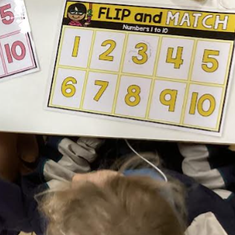
Child 3 - 5.5Y G
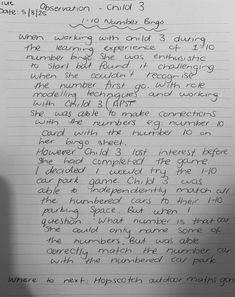
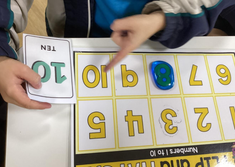

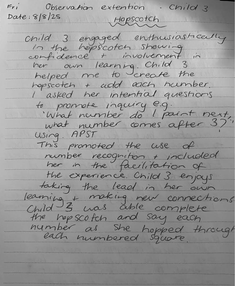
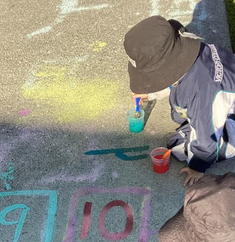
EYLF 4.1: Children develop a growth mindset and learning dispositions such as curiosity, cooperation, confidence, creativity, commitment, enthusiasm, persistence, imagination and reflexivity
EYLF 4.3: Children transfer and adapt what they have learned from one context to another
QKLG: 5.3 Building numeracy in personally meaning ways.
APST 2.1 Content and teaching strategies of the teaching area: Demonstrate knowledge and understanding of the concepts, substance and structure of the content and teaching strategies of the teaching area
APST 2.2 Content selection and organisation: Organise content into an effective learning and teaching sequence.
APST 3.2 Plan, structure and sequence learning programs: Plan lesson sequences using knowledge of student learning, content and effective teaching strategies.
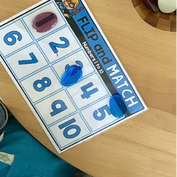
Child 8 - 4.5Y B

EYLF 4.1: Children develop a growth mindset and learning dispositions such as curiosity, cooperation, confidence, creativity, commitment, enthusiasm, persistence, imagination and reflexivity
EYLF 4.3: Children transfer and adapt what they have learned from one context to another
QKLG: 5.3 Building numeracy in personally meaning ways.
APST 2.1 Content and teaching strategies of the teaching area: Demonstrate knowledge and understanding of the concepts, substance and structure of the content and teaching strategies of the teaching area
APST 2.2 Content selection and organisation: Organise content into an effective learning and teaching sequence.
APST 3.2 Plan, structure and sequence learning programs: Plan lesson sequences using knowledge of student learning, content and effective teaching strategies.
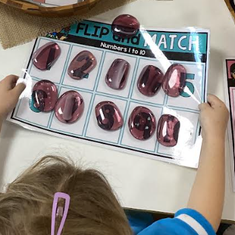
Child 7 - 4.5Y G
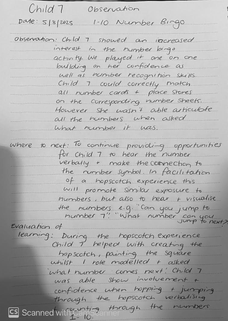
EYLF 4.1: Children develop a growth mindset and learning dispositions such as curiosity, cooperation, confidence, creativity, commitment, enthusiasm, persistence, imagination and reflexivity
EYLF 4.3: Children transfer and adapt what they have learned from one context to another
QKLG: 5.3 Building numeracy in personally meaning ways.
APST 2.1 Content and teaching strategies of the teaching area: Demonstrate knowledge and understanding of the concepts, substance and structure of the content and teaching strategies of the teaching area
APST 2.2 Content selection and organisation: Organise content into an effective learning and teaching sequence.
APST 3.2 Plan, structure and sequence learning programs: Plan lesson sequences using knowledge of student learning, content and effective teaching strategies.
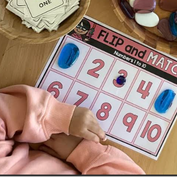
Child 4 - 4Y G
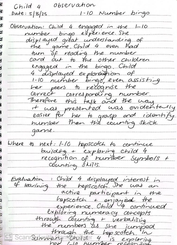
EYLF 4.1: Children develop a growth mindset and learning dispositions such as curiosity, cooperation, confidence, creativity, commitment, enthusiasm, persistence, imagination and reflexivity
EYLF 4.3: Children transfer and adapt what they have learned from one context to another
QKLG: 5.3 Building numeracy in personally meaning ways.
APST 2.1 Content and teaching strategies of the teaching area: Demonstrate knowledge and understanding of the concepts, substance and structure of the content and teaching strategies of the teaching area
APST 2.2 Content selection and organisation: Organise content into an effective learning and teaching sequence.
APST 3.2 Plan, structure and sequence learning programs: Plan lesson sequences using knowledge of student learning, content and effective teaching strategies.
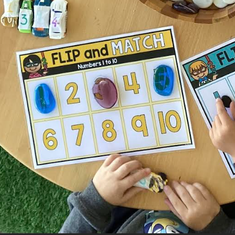
Child 5 - 4Y B
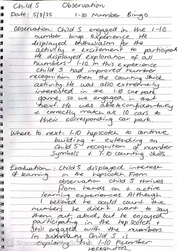
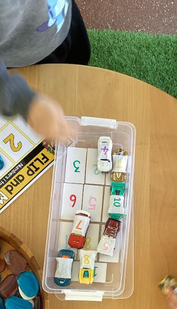

EYLF 4.1: Children develop a growth mindset and learning dispositions such as curiosity, cooperation, confidence, creativity, commitment, enthusiasm, persistence, imagination and reflexivity
EYLF 4.3: Children transfer and adapt what they have learned from one context to another
QKLG: 5.3 Building numeracy in personally meaning ways.
APST 2.1 Content and teaching strategies of the teaching area: Demonstrate knowledge and understanding of the concepts, substance and structure of the content and teaching strategies of the teaching area
APST 2.2 Content selection and organisation: Organise content into an effective learning and teaching sequence.
APST 3.2 Plan, structure and sequence learning programs: Plan lesson sequences using knowledge of student learning, content and effective teaching strategies.
Shadow Tracing - Individual Observations
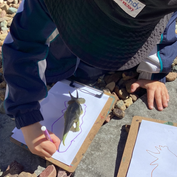
Child 3 - 5.5Y G
Observation: This week is National Science Week 2025, today, to facilitate experiences that engage children in hypothesis, experimentation and inquiry we set up a shadow drawing experience. With the focus being encouraging children to problem solve and transfer and adapt what they have learnt from one context to another. To trace the outline of the shadow casted from the dinosaur. Child 5 said “I’m drawing the dinosaur and his spikes, it’s a bit hard.. but I moved and I can see it now”.
Analysis of learning: Through investigation, Child 5 was able to problem solve how to attempt the task. She worked out which side of the paper to sit on so she could see the shadow of the dinosaur to trace. Child 5 displayed positive dispositions towards learning. Developing a range of new skills and problem solving techniques.
Extension of learning: To extend on this experience, we will continue investigating through shadow science, first starting with looking at our own bodies and shadows created outside by an external light source e.g: the sun. Creating a shadow of our bodies or object and asking a friend or teacher to trace around the shadow on the ground using chalk. Assisting the children to understand how shadows are formed. Then using chalk paint to colour in the shadows on the ground.
EYLF 4.1: Children develop a growth mindset and learning dispositions such as curiosity, cooperation, confidence, creativity, commitment, enthusiasm, persistence, imagination and reflexivity
EYLF 4.3: Children transfer and adapt what they have learned from one context to another
QLKG 4.1: Building positive dispositions toward learning
QKLG 4.2: Showing confidence and involvement in learning
APST 2.1: Content and teaching strategies of the teaching area: Demonstrate knowledge and understanding of the concepts, substance and structure of the content and teaching strategies of the teaching area
APST 3.1: Establish challenging learning goals
Set learning goals that provide achievable challenges for students of varying abilities and characteristics.
APST 3.2: Plan, structure and sequence learning programs: Plan lesson sequences using knowledge of student learning, content and effective teaching strategies
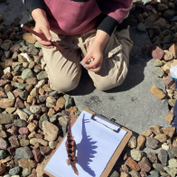
Child 6 - 3.5Y B
Observation: This week is National Science Week 2025, today, to facilitate experiences that engage children in hypothesis, experimentation and inquiry we set up a shadow drawing experience. With the focus being encouraging children to problem solve and transfer and adapt what they have learnt from one context to another. To trace the outline of the shadow casted from the dinosaur. Child 6 explained “I can’t do it” so we worked together to follow the lines and draw the dinosaur. Afterwards he exclaimed “Its a stegosaurus” Child 6 is displaying emerging confidence and involvement in her learning.
Analysis of learning: Through investigation, Child 6 was able to problem solve how to attempt the task. He worked out which side of the paper to sit on so he could see the shadow of the dinosaur to draw. Child 6 displayed positive dispositions towards learning. Developing a range of new skills and problem solving techniques.
Extension of learning: To extend on this experience, we will continue investigating through shadow science, first starting with looking at our own bodies and shadows created outside by an external light source e.g: the sun. Creating a shadow of our bodies or object and asking a friend or teacher to trace around the shadow on the ground using chalk. Assisting the children to understand how shadows are formed. Then using chalk paint to colour in the shadows on the ground.
EYLF 4.1: Children develop a growth mindset and learning dispositions such as curiosity, cooperation, confidence, creativity, commitment, enthusiasm, persistence, imagination and reflexivity
EYLF 4.3: Children transfer and adapt what they have learned from one context to another
QLKG 4.1: Building positive dispositions toward learning
QKLG 4.2: Showing confidence and involvement in learning
APST 2.1: Content and teaching strategies of the teaching area: Demonstrate knowledge and understanding of the concepts, substance and structure of the content and teaching strategies of the teaching area
APST 3.1: Establish challenging learning goals
Set learning goals that provide achievable challenges for students of varying abilities and characteristics.
APST 3.2: Plan, structure and sequence learning programs: Plan lesson sequences using knowledge of student learning, content and effective teaching strategies
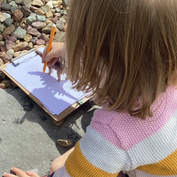
Child 7 - 4.5Y G
Observation: This week is National Science Week 2025, today, to facilitate experiences that engage children in hypothesis, experimentation and inquiry we set up a shadow drawing experience. With the focus being encouraging children to problem solve and transfer and adapt what they have learnt from one context to another. To trace the outline of the shadow casted from the dinosaur. Child 7 said “I did it” “I traced around the shadow”, displaying confidence and involvement in her learning.
Analysis of learning: Through investigation, Child 7 was able to problem solve how to attempt the task. She worked out which side of the paper to sit on so she could see the shadow of the dinosaur to trace. Child 7 displayed positive dispositions towards learning. Developing a range of new skills and problem solving techniques.
Extension of learning: To extend on this experience, we will continue investigating through shadow science, first starting with looking at our own bodies and shadows created outside by an external light source e.g: the sun. Creating a shadow of our bodies or object and asking a friend or teacher to trace around the shadow on the ground using chalk. Assisting the children to understand how shadows are formed. Then using chalk paint to colour in the shadows on the ground.
EYLF 4.1: Children develop a growth mindset and learning dispositions such as curiosity, cooperation, confidence, creativity, commitment, enthusiasm, persistence, imagination and reflexivity
EYLF 4.3: Children transfer and adapt what they have learned from one context to another
QLKG 4.1: Building positive dispositions toward learning
QKLG 4.2: Showing confidence and involvement in learning
APST 2.1: Content and teaching strategies of the teaching area: Demonstrate knowledge and understanding of the concepts, substance and structure of the content and teaching strategies of the teaching area
APST 3.1: Establish challenging learning goals
Set learning goals that provide achievable challenges for students of varying abilities and characteristics.
APST 3.2: Plan, structure and sequence learning programs: Plan lesson sequences using knowledge of student learning, content and effective teaching strategies.
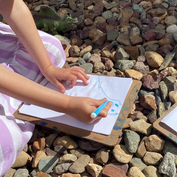
Child 2 - 4.5Y G
Observation: This week is National Science Week 2025, today, to facilitate experiences that engage children in hypothesis, experimentation and inquiry we set up a shadow drawing experience. With the focus being encouraging children to problem solve and transfer and adapt what they have learnt from one context to another. To trace the outline of the shadow casted from the dinosaur. Child 2 said “I traced it, the dinosaur”.. “It was easy to trace it”. Displaying confidence and Involvement in her learning.
Analysis of learning: Through investigation, Child 2 was able to problem solve how to attempt the task. She worked out which side of the paper to sit on so she could see the shadow of the dinosaur to trace. Child 2 displayed positive dispositions towards learning. Developing a range of new skills and problem solving techniques.
Extension of learning: To extend on this experience, we will continue investigating through shadow science, first starting with looking at our own bodies and shadows created outside by an external light source e.g: the sun. Creating a shadow of our bodies or object and asking a friend or teacher to trace around the shadow on the ground using chalk. Assisting the children to understand how shadows are formed. Then using chalk paint to colour in the shadows on the ground.
EYLF 4.1: Children develop a growth mindset and learning dispositions such as curiosity, cooperation, confidence, creativity, commitment, enthusiasm, persistence, imagination and reflexivity
EYLF 4.3: Children transfer and adapt what they have learned from one context to another
QLKG 4.1: Building positive dispositions toward learning
QKLG 4.2: Showing confidence and involvement in learning
APST 2.1: Content and teaching strategies of the teaching area: Demonstrate knowledge and understanding of the concepts, substance and structure of the content and teaching strategies of the teaching area
APST 3.1: Establish challenging learning goals
Set learning goals that provide achievable challenges for students of varying abilities and characteristics.
APST 3.2: Plan, structure and sequence learning programs: Plan lesson sequences using knowledge of student learning, content and effective teaching strategies
Signed Consent & Permission Forms
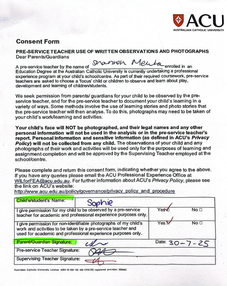
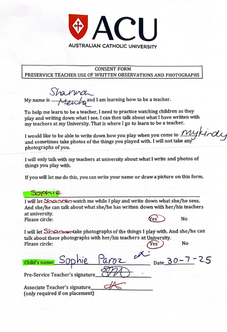
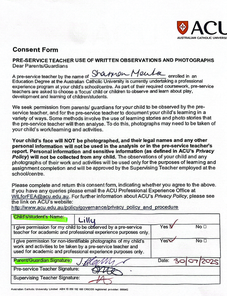
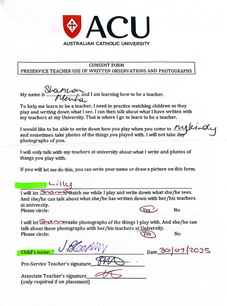
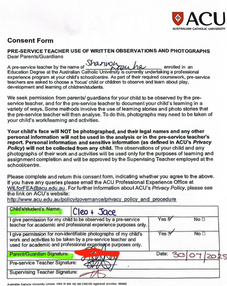
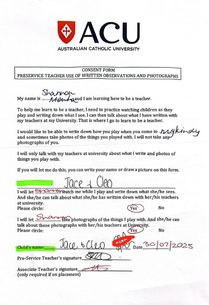
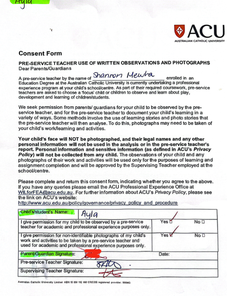
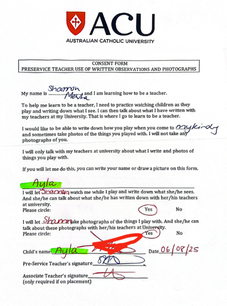
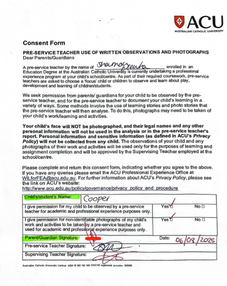
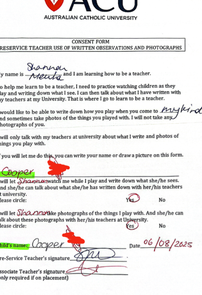
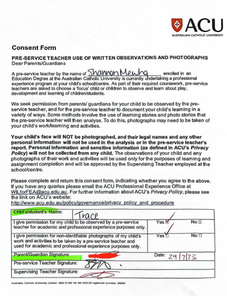
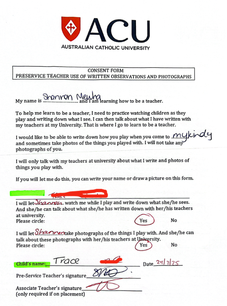
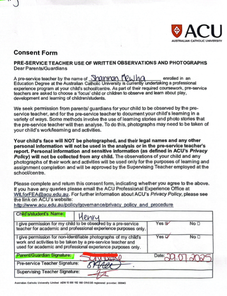
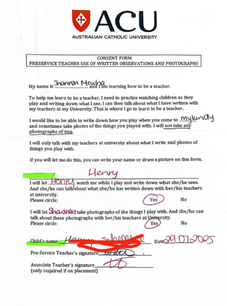
Create Your Own Website With Webador